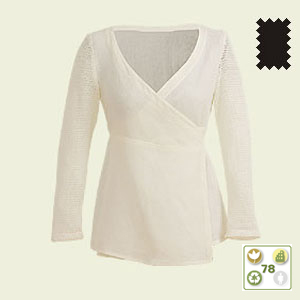You don’t have to be an eco-fashionista to see that there is a new sustainable sub-industry evolving in the fashion world and on Madison Avenue. There are shoes made from ex-Jeep bits, a wide variety of styles of clothes made from bamboo, organic cotton and now soy fibers.
Historically, the clothing manufacturing industry has served as the poster child for bad ethical behavior and unsustainable business practices. From sweatshops and unfair trade to the questionable materials used and shipped thousands of miles before landing in Wal-Mart.
Well, we are a demanding lot. ‘We’, the collective consumers in the US primarily, want lots of clothes, we only want them for maybe a year before tossing them, and we don’t want to pay much for them either. Over the past 10 years we have developed a hankering for fast fashion. Similar to fast food, fast fashion is quick, cheap and considered virtually disposable.
Some eye-popping facts about the garment industry:
· According to the USDA, cotton is responsible for 25% of all the pesticides used in the US
· Due to the high demand and highly negative environmental impact of polyester and other synthetic textile production, the EPA under the Resource Conservation and Recovery Act has classified textile manufacturing facilities as ‘hazardous waste generators’.
· According to the UN Commodity Trade Statistics database, Chinese manufactured clothing accounts for 30% of the global apparel exports. I don’t have the statistics on how much of that comes to the US, but I bet it is a large percentage of that 30% and folks, that is a long carbon footprint. Not to mention that China does not have the same standards for industrial pollution we do . . . or for fair working conditions . . .
o Pietra Rivoli, a professor at the McDonough School of Business at Georgetown University, surmised in her book The Travels of a T-Shirt in the Global Economy, that each year Americans buy 1 billion pieces of clothing made in China – that’s almost 4 items for each American!
o The US National Labor Committee reports that some Chinese garment workers earn 12 – 18 cents per hour and work in dangerous and unhealthy conditions.
There is no way in a 500-word article to report all the various resources drained, toxins unleashed and how big and bad the giant carbon footprint of the industrial method to deliver fast fashion actually is. I’ll ask that you trust me on this or suggest doing further research on the topic. I’m more interested in talking about some of the innovators helping to make a dent of change in this industrial beast.
There are solutions!
Recycle. Reuse!
First of all, not enough can be said for the benefit of discovering your local consignment shop. My daughters and I have always been shameless used clothing lovers. Two clever moms created a booming franchise business called Milk Money, which offers used children’s clothing. It started as a way to create a solution for their own desire to share clothing with other mothers in their community and they ended up making a very chic environment within their stores that mothers and children enjoy lingering in.
Buy Local
Most of our clothes do a lot of travelling, which is not so good for the global carbon footprint. Whenever possible, find locally/regionally manufactured clothing. This may take a little homework, but some Internet sleuthing coupled with visits to small clothing stores may yield some interesting finds.
Know Where Your Garment Has Been
As I mentioned a few paragraphs ago, there is an increased demand for more sustainable clothing and there are thousands of innovators and entrepreneurs taking up the call to create eco-chic clothing that costs less in environmental and human terms. Maybe not so much less in terms of dollars, but as with any commodity, as the supply increases to meet the demand, the pricing will come down. Meanwhile, I’d rather have fewer garments that are thoughtfully made than a closet full of fast fashion.
Two notable companies have created transparency in their manufacturing chains and offer consumers a way to track the origins of their garment and its trip to their closet or drawer. There are probably many following suit, but these are ones that I have direct experience with in terms of reviewing their product and tracing the trail of the clothes they sent me:
· Icebreakers – Icebreaker CEO Jeremy Moon says sustainability has been a non-negotiable part of the company’s core philosophy since it was founded in 1994. Since then, Icebreaker has emerged as an innovator in merino-based outdoor layering systems, claiming to be the first apparel company in the world to source merino direct from growers. Icebreaker CEO Jeremy Moon says sustainability has been a non-negotiable part of the company’s core philosophy since it was founded in 1994. Since then, Icebreaker has emerged as an innovator in merino-based outdoor layering systems, claiming to be the first apparel company in the world to source merino direct from growers. (read my review of the Icebreaker hoodie and the Baacode)
· Bernardo Green – Bernardo Fashions has developed a sustainable clothing line, called Bernardo Green, which is an eco-friendly suede collection made of biodegradable materials. One of the things Bernardo Fashion is known for is being the innovator of washable suede. Bernardo sticks primarily to outerwear. Bernardo Green offers a ‘code’ which allows trackability of the garment and its entire journey. (reach my review of the awesome Bernardo Green suede jacket)
Green Standards?
As I review more and more ‘green’ products these days, I’m kind of baffled that there isn’t more of a standardized rating system. I googled ‘green product standards’ and I found the Green Seal of course, which is great for paper products and cleaners. The EPA even has a database for information on environmental products and services – if you go there and you can figure out what the standards are and actually find product lists, please let me know! It’s a little confusing.
BuyGreen.com seems to have a rating system that works. It is a flexible system and offers an opportunity to become more educated about certain types of products and their inherent characteristics in terms of their basic product life cycle. It lends itself well to clothing products.
The four main categories are designed to rate a product from ‘cradle to grave’ and represent a product’s ‘basic lifecycle’. The categories used are: source material, manufacturing, use, and disposal. Every product offered on their website uses a rating box, which has all four of these categories represented by an icon. If the product meets or exceeds that category’s requirements, it will be displayed in color. If not, it is there, but in grey.
There is also a number rating for overall green attributes 1 – not so many: 100 – lots of good green attributes.
You can see an example of this on the image [at the top of this post]. Note that this hemp blouse, has a fairly good rating.
eat. blog. be merry!



One Comment